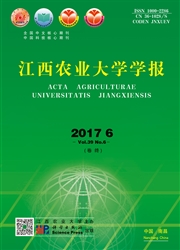

 中文摘要:
中文摘要:
受流域人类活动及工业化影响,鄱阳湖湿地已遭受重金属污染,黎蒿是湖区居民喜欢食用的一种生长于鄱阳湖湿地的野生植物。为了解鄱阳湖湿地土壤污染状况及黎蒿的食用安全,采集了鄱阳湖湿地不同河口区土壤及藜蒿样品,测定了土壤样品中Cu、Pb、Cd及黎蒿样品中Cd含量,并对其污染状况进行了评价。污染综合指数评价表明,土壤重金属综合污染指数平均值为13.92,属于严重污染级;通过潜在生态风险评价发现,鄱阳湖区土壤重金属平均潜在生态危害指数为201.64,属于中等生态危害风险等级。经藜蒿与对应土壤样品中Cd含量比较发现,藜蒿对Cd具有较强富集能力,富集系数平均为1.65;转运系数(平均为2.74)结果显示Cd在藜蒿植株内易转运到地上部(茎叶),即居民采食部分。通过对照国家食品(茎叶类蔬菜)安全标准,发现藜蒿地上部Cd含量超过标准值11.70-25.70倍,故采食鄱阳湖河口地带藜蒿存在较大安全隐患。
 英文摘要:
英文摘要:
Affected by industrialization and human activities, the ecological deterioration of Poyang Lake wetland had drawn more and more social attentions. To study the pollution degree of wetland soil of Poyang Lake and the edible safety of Artemisia selengensis, the levels of Cu, Pb, Cd in soil and the content of Cd in A. selengensis collected from the estury areas in Poyang Lake wetland were surveyed.The results indicate that the estuaries of four rivers disemboguing into Poyang Lake have been polluted by heavy metals : the average comprehensive pollution index is 13.92 ,and the average potential ecological risk index is 201.64 ,which is classified as medium contamination class.A.selengensis has a strong enrichment ability viewed from the comparison of the content of Cd in A.selengensis and that in the soil.The enrichment index is 1.65 and the transfer coefficient is 2.74, which shows that Cd in A.selengensis can easily be transferred from root to shoot, which people prefer to take as an vegetable.According to The National Food Safety Standards, the content of Cd in edible part of A. selengensis is 11.70-25.70 times the standard' s value, which means there will be a huge threat to peoples health who takes it as a food.
 同期刊论文项目
同期刊论文项目
 同项目期刊论文
同项目期刊论文
 期刊信息
期刊信息
